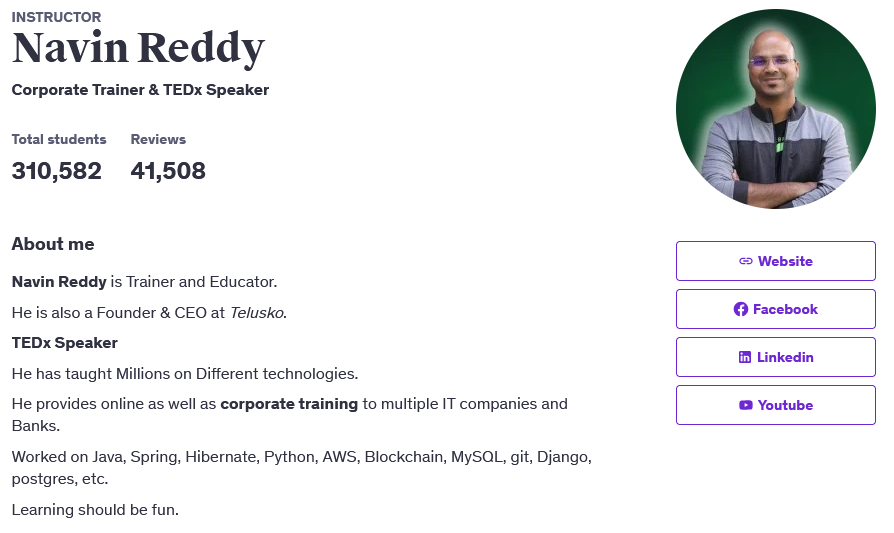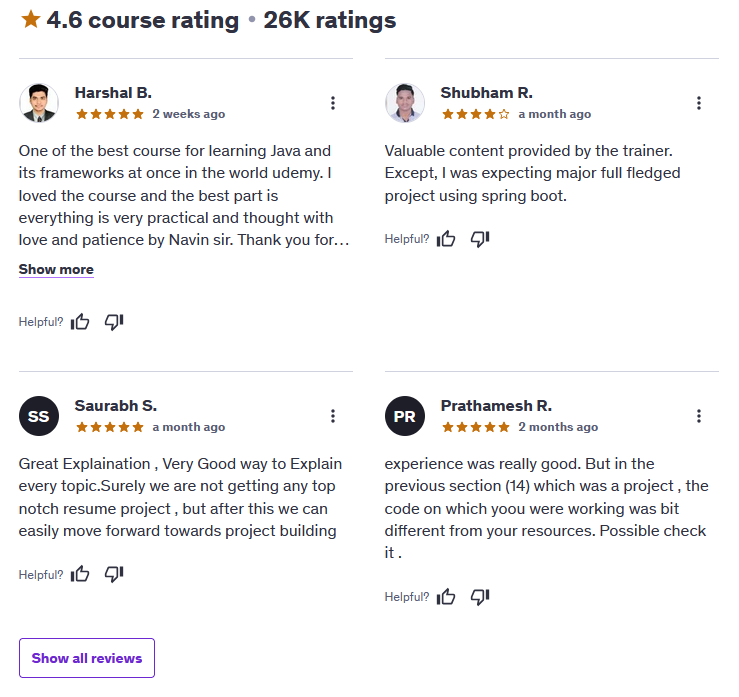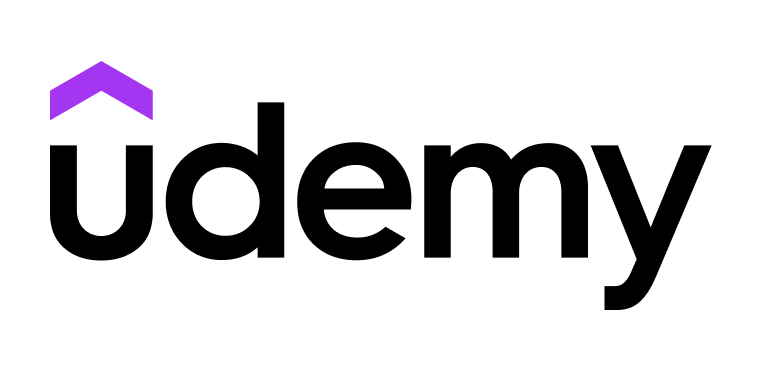So, you’re thinking about diving into Java Spring Framework 6 with Spring Boot 3 on Udemy? Maybe you’re a Java developer looking to level up or a beginner hoping to break into enterprise development. Either way, I’ve gone through the course details, the instructor’s background, and student reviews to give you the real scoop.
Let’s break it all down!
Instructor Reputation
When you’re about to invest your time (and money) into an online course, the first thing you need to ask is: Is the instructor actually good? You don’t want to sit through hours of uninspired, monotone lectures where an instructor reads off slides like a robot.
Well, good news—Navin Reddy is NOT that guy.

Who is Navin Reddy?
Navin is not just another Udemy instructor—he’s a corporate trainer, TEDx speaker, and the Founder & CEO of Telusko, a platform dedicated to teaching programming and technology. If you’ve ever searched for Java or Spring Boot tutorials on YouTube, chances are you’ve come across one of his free lessons.
Here’s a quick glance at his credentials:
- 4.6-star instructor rating on Udemy (which is excellent considering the massive number of students he’s taught).
- 310,000+ students enrolled across his courses. That’s almost the population of a small city!
- Over 41,000 reviews, mostly positive. This means people aren’t just signing up for his courses but are also finding them valuable enough to leave feedback.
- Has provided corporate training for IT companies and banks, meaning his knowledge isn’t just theoretical—it’s practical, industry-level expertise.
Why Students Love Navin Reddy
Students consistently praise his clear explanations and practical approach. He has a knack for making even complex Java and Spring concepts feel approachable, and he keeps his lessons engaging.
A few things that stand out about his teaching style:
✅ Simplifies difficult topics – Spring Boot can be a beast, but Navin breaks it down step by step.
✅ Hands-on learning approach – You’re not just passively watching; you’re coding along with him.
✅ Focuses on real-world application – Instead of just teaching theory, he helps you see how you’d actually use these concepts in enterprise applications.
✅ Friendly and engaging – Students describe him as a patient and approachable teacher who truly enjoys sharing his knowledge.
Are There Any Downsides?
Of course, no instructor is perfect. Some students mention that they expected a bigger final project, and a few found minor inconsistencies in the project section. However, these are relatively small complaints compared to the overwhelmingly positive feedback.
Bottom Line: If you’re looking for an instructor who knows Java and Spring inside out, can explain it in a way that actually makes sense, and keeps things engaging, Navin Reddy is a fantastic choice.
Course Structure
Spring Framework is huge—and that’s putting it lightly. It consists of multiple modules, components, and best practices, which can make learning it overwhelming if you don’t have the right roadmap.

Luckily, Java Spring Framework 6 with Spring Boot 3 is structured to guide you from beginner to advanced concepts in a logical way. Let’s break it down:
1. Foundations of Java and Spring
Before you dive deep into Spring Boot and microservices, you need a strong foundation in Java. This course ensures that even if you’re a beginner, you’ll understand core Java concepts before moving on.
Key topics in this section:
- Core Java principles (OOP, methods, classes, and interfaces)
- Introduction to the Spring ecosystem – Why use Spring? What problems does it solve?
- Dependency Injection and IoC (Inversion of Control) – One of the most fundamental concepts in Spring development.
💡 Why This Matters: Many Spring courses assume you already know this, but this course walks you through it, making sure you’re truly ready.
2. Spring Boot: The Game-Changer
Once you have the basics down, you’ll move into Spring Boot, which is an absolute must-learn if you’re a Java developer.
Topics covered:
- Spring Boot Basics – What makes Spring Boot different from Spring Core?
- Building Your First Spring Boot Application – Coding from scratch!
- Maven & Dependency Management – Because no one likes painful project setup.
- Spring Boot Auto-Configuration & Annotations – The magic that simplifies Spring development.
💡 Why This Matters: Spring Boot takes the complexity out of traditional Spring applications and makes development faster and more streamlined. This section ensures you get hands-on experience with it.
3. Spring MVC & REST APIs: Backend Development Essentials
Now that you have Spring Boot under your belt, it’s time to learn how to build web applications and REST APIs.
Topics covered:
- Spring MVC (Model-View-Controller) – Structuring your applications the right way.
- Handling HTTP Requests & Responses – Learn how web apps communicate with the backend.
- Building RESTful APIs with Spring Boot – Essential for modern web and mobile applications.
- Error Handling & Exception Management – Making sure your APIs are robust.
💡 Why This Matters: If you ever want to build a backend for a real-world application, this section is non-negotiable.
4. Spring Security: Protecting Your Application
Security is a huge part of enterprise application development, and this course covers:
- User authentication & authorization
- Securing APIs with JWT (JSON Web Tokens)
- Role-based access control
💡 Why This Matters: Companies won’t hire you to build web applications if they aren’t secure!
5. Data Management: Spring Data JPA & Database Integration
Handling data efficiently is key for enterprise applications. This section covers:
- JDBC & Database Connectivity
- Spring Data JPA – How to interact with databases without writing a ton of SQL.
- CRUD Operations (Create, Read, Update, Delete) – The bread and butter of backend development.
💡 Why This Matters: If you want to build any application that stores and retrieves data, these skills are a must.
6. Docker & Microservices: The Modern Development Toolkit
Finally, this course introduces you to Docker & Microservices, which are essential for scalable and flexible applications.
Topics covered:
- Understanding Microservices Architecture
- Building Microservices with Spring Boot
- Deploying Spring Apps with Docker
💡 Why This Matters: Microservices and containerization are the future of software development. Even if you’re not working with them now, learning them gives you a competitive edge.
Content Quality
When it comes to online learning, content quality can make or break a course. A great topic, a knowledgeable instructor, and a well-structured syllabus mean nothing if the actual content feels outdated, rushed, or lacks depth. So, does Navin Reddy’s Java Spring Framework 6 with Spring Boot 3 actually live up to its promise?

Let’s break it down into four key areas: depth of material, hands-on learning, real-world application, and overall engagement.
1. Depth of Material: Comprehensive or Surface-Level?
One of the best aspects of this course is that it covers everything you need to know about Spring Framework and Spring Boot in a single package. You’re not just scratching the surface—you’re diving deep into topics like:
✅ Spring Core & Dependency Injection – Essential for writing clean, modular Java applications.
✅ Spring MVC & REST APIs – Building the backend of a web app with proper structure.
✅ Spring Data JPA – Handling databases the modern way without writing tons of boilerplate SQL.
✅ Spring Security – Learning how to lock down your applications with authentication and authorization.
✅ Docker & Microservices – Deploying your apps using modern containerized environments.
That being said, while the coverage is broad and well-explained, some students noted that certain advanced microservices topics (like API Gateway or distributed transactions) could have been explored in greater detail. If you’re looking for an ultra-deep dive into microservices, you may need an additional specialized course.
2. Hands-On Learning: Do You Actually Get to Code?
No one wants to sit through hours of slides and theoretical lectures. The good news? This course is NOT just theory—Navin codes everything from scratch, which means you’ll:
✔️ Write real code alongside the instructor – No passive learning here.
✔️ Build actual applications – From basic concepts to a functional backend.
✔️ Understand best practices – Learn how professional developers structure their Spring Boot projects.
However, some students noted that while the coding exercises are great for learning individual concepts, the course lacks a large-scale, end-to-end project. It would have been amazing to see a complete enterprise-level project that ties everything together in a single, well-documented system.
3. Real-World Application: Can You Use This in a Job?
Spring Boot is one of the most in-demand skills in enterprise software development, and this course gives you a solid foundation to start working with it professionally.
✅ Best for aspiring backend developers – If you’re planning to work with Java in enterprise applications, this is a must-know framework.
✅ Covers industry standards – Spring Security, REST APIs, JPA, and Docker are all used in real-world applications.
✅ Prepares you for professional projects – You’ll understand how Spring apps are built, deployed, and scaled.
However, while the concepts are solid, you may need additional real-world project experience before you feel fully confident in a job setting. This is where supplementing the course with self-built projects can make a big difference.
4. Engagement: Is the Content Dry or Fun?
Learning Java and Spring could be dry, but Navin Reddy does a great job of keeping things engaging. His teaching style is lively, clear, and practical, which makes the learning experience feel interactive rather than boring.
Overall Course Rating – 8.5/10
Let’s cut to the chase: Java Spring Framework 6 with Spring Boot 3 scores an 8.5/10. It’s a fantastic choice for Java developers who want to master Spring Boot and enterprise-level backend development, but it does have a few areas where it could improve.

Who Should Take This Course?
✅ Beginner to Intermediate Java Developers – If you already know basic Java but want to specialize in Spring and backend development, this is a perfect next step.
✅ Aspiring Backend Developers – Learning Spring Boot is one of the best ways to enter enterprise Java development.
✅ Anyone Who Wants Hands-On Learning – If you hate passive learning and want to code along, this course delivers.
Who Might Not Find It Ideal?
❌ Developers Looking for a Single Massive Project – While there are tons of coding exercises, a large-scale, start-to-finish enterprise project is missing.
❌ Absolute Beginners to Java – If you’ve never coded in Java before, you might struggle with some sections.
❌ Those Wanting an Advanced Deep Dive on Microservices – This course introduces microservices but doesn’t go into the most advanced topics.
What Students Loved the Most
- Clear explanations – Complex topics are broken down into bite-sized, digestible lessons.
- Navin’s teaching style – He keeps things engaging, practical, and fun.
- Well-structured syllabus – The course follows a logical progression, making it easy to follow.
Where It Could Be Even Better
- A bigger, real-world final project would make this a 10/10 course.
- A slightly deeper dive into microservices would be beneficial.
- Some resource inconsistencies in the project section could be improved.



